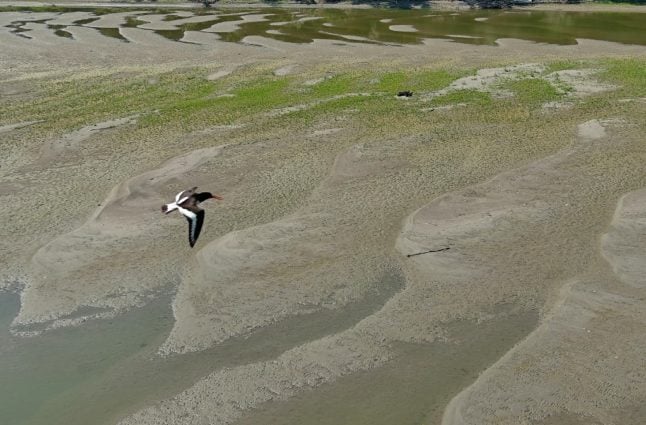Italy experienced its worst drought in 70 years last summer, with the government declaring a state of emergency in five northern regions (Emilia-Romagna, Friuli-Venezia Giulia, Lombardy, Piedmont and Veneto) and many parts of the country independently bringing in water use restrictions.
But the threat of another record drought is currently looming over the country, as an exceptionally dry winter – the Alps have received less than half of their normal snowfall so far – has already critically reduced the water levels of many Italian rivers and lakes, especially in the north of the country.
READ ALSO: How climate change left Italy’s ski resorts fighting for survival
The Po, Italy’s longest river and largest reservoir of fresh water, currently has 61 percent less water than normal at this time of the year.
Vast sections of the river are already parched: in the Pavia the water level is now three metres below the zero gauge.
But Italy’s largest lake, Lake Garda, is also bearing the brunt of a winter with little to no rain or snowfall. The lake is currently registering the lowest wintertime water levels in 35 years, making it possible for residents to reach the island of San Biagio on foot.

What can we expect in the coming months?
Whether or not Italy will face a drought as serious as last year’s will largely depend on weather conditions in the next three months, which are usually the rainiest time of the year for many regions in the north.
READ ALSO: Record-breaking winter temperatures warm Europe
According to Massimiliano Pasqui, a researcher at Italy’s National Research Council (CNR), rainfall in the coming months may compensate for the dry weather of the past few weeks, but northwestern regions will need at least “50 days of rain”, which are roughly equivalent to 500 millimetres of accumulated rainfall.
That said, should the current lack of rain continue (or further aggravate) in springtime, Italy would end up facing many of the problems that it experienced last summer.
Last year’s drought caused €6 billion worth of damage to Italian agriculture, with the country losing a third of its crops, according to data from farmers’ association Coldiretti.
Another severe water emergency would likely result in similar losses, once again endangering the survival of countless businesses across the country.

But Italy might also encounter issues regarding its drinking water supplies. In particular, the ‘flow back’ of salt water into river deltas (salt water was found nearly 40 kilometres up the Po river last year) might make many aquifers unusable without the employment of desalinators.
Finally, a future drought might also impair the production of hydroelectric power across the country at a time when Italy is gradually transitioning away from fossil energy sources.
Environmental groups including Legambiente have urged the government to draft a “national water plan” to prevent a repeat of last year’s national emergency.



 Please whitelist us to continue reading.
Please whitelist us to continue reading.
Member comments